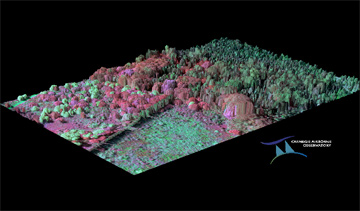‘CAT scan’ shows Hawaiian forests invaded by alien species
‘CAT scan’ shows Hawaiian forests invaded by alien species
mongabay.com
March 3, 2008
|
|
Invasive plant species are altering the ecology of Hawaiian rain forests, reports a study published in the Proceedings of the National Academy of Sciences (PNAS).
Using a new type of remote sensing technology on aircraft to create a three-dimensional structure of more than 220,000 hectares of rain forest on the island of Hawaii, researchers led by Gregory Asner of the Carnegie Institutionâs Department of Global Ecology found that invasives are changing the basic ecological structure of Hawaiian forests.
Asner says that the technology penetrates the forest canopy to “create a regional ‘CAT scan’ of the ecosystem, identifying key plant species and mapping the forest’s three-dimensional structure.”
“Invasive tree species often show biochemical, physiological, and structural properties that are different from native species,” explained Asner. “We can use these ‘fingerprints’ combined with the 3-D images to see how the invasives are changing the forest.”
The researchers found that invasive tree species affect forests in several ways, from reducing the amount of light that reaches the forest floor to changing soil chemistry.
 3-D Imaging of Invasive Tree Species (reds-pinks) and Native Hawaiian Lowland Rainforest (greens) |
“Undisturbed Hawaiian rain forests are often dominated by the ohia tree (Metrosideros polymorpha), but these slow-growing native trees are losing ground to newcomers, such as the tropical ash (Fraxinus uhdei) and the Canary Island fire tree (Morella faya),” explained a news release from the Carnegie Institution. “CAO surveys of rain forest tracts on the Mauna Kea and Kilauea Volcanoes found that stands of these two invasive tree species form significantly denser canopies than the native ohia trees. Less light reaches lower forest levels, and as a result native understory plants such as tree ferns are suppressed. Introduced trees can also pave the way for more invaders by altering soil fertility. The Moluccan albizia (Falcataria moluccana) ‘fixes’ atmospheric nitrogen, concentrating it in the soil, which speeds the growth of a smaller invasive tree, the Strawberry Guava (Psidium cattleianum). The guava trees form a dense, mid-level thicket that blocks most light from reaching the ground and stifles young native plants.”
“All of our invasive species detections were made in protected state and federal rain forest reserves,” added Asner. “These species can spread across protected areas without the help of land use changes or other human activities, suggesting that traditional conservation approaches on the ground aren’t enough for the long-term survival of Hawaiiâs rain forests.”
“These new airborne technologies, which are sensitive enough to discern saplings and young trees, may make the problem more tractable,” said study co-author Flint Hughes of the US Forest Service. “They allow scientists to probe the make-up of forests over large areas and detect invasions at earlier stages.”
Overall, more than half the organisms in Hawaii are non-native.
This article uses quotes and information from the AP